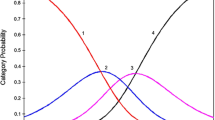Abstract
The psychometric properties of the Autism Behavior Checklist (ABC; Krug, Arick, & Almond, 1980a, 1980b), a 57-item screening checklist for autism was investigated. Professional Informants completed the ABC on 67 autistic and 56 mentally retarded and learning-disabled children. The autistic children were the total population of autistic children aged 6–15 in two circumscribed suburban and rural regions. Using the total score, the ABC accurately discriminated 91% of the children, with 87% of the autistic and 96% of the nonautistic group correctly classified. Moreover, the accuracy of classification was virtually identical when only the more heavily weighted checklist items were used. A 3-factor model accounted for 32% of the total variance in the checklist. Seventeen items loaded.4 or more on Factor 1, 12 items loaded on Factor 2, and 10 items loaded on Factor 3. The present results fail to provide empirical support for a single unidimensional scale for autism. Also, there is little support for subdividing the checklist into five subscales based on symptom areas.
Similar content being viewed by others
References
American Psychiatric Association, (1987).Diagnostic and statistical manual of mental disorders (3rd ed., rev.). Washington, DC: Author.
Bryson, S. E., Clark, B. S., & Smith, I. M. (1988). First report of a Canadian epidemiological study of autistic syndromes.Journal of Child Psychology and Psychiatry, 29, 433–445.
Denckla, M. B. (1986). Editorial: New diagnostic criteria for autism and related behavioral disorders—Guidelines for research protocol.Journal of the American Academy of Child Psychiatry, 25, 221–224.
Krug, D. A., Arick, J. R., & Almond, P. J. (1980a).Autism screening instrument for educational planning. Examiner's manual. Portland, OR: ASIEP Education Company.
Krug, D. A., Arick, J. R., & Almond, P. J. (1980b). Behavior checklist for identifying severely handicapped individuals with high levels of autistic behavior.Journal of Child Psychology and Psychiatry, 21, 221–229.
McDonald, R. (1985).Factor analysis and related methods. Hillsdale, NJ: Erlbaum.
Parks, S. L. (1983). The assessment of autistic children: A selective review of available instruments.Journal of Autism and Developmental Disorders, 13, 255–267.
Rutter, M., & Schopler, E. (1987). Autism and pervasive developmental disorders: Concepts and diagnostic issues.Journal of Autism and Developmental Disorders, 17, 159–186.
SPSS Inc. (1985).SPSS x:Advanced statistics guide. New York: McGraw-Hill.
Stutsman, R. (1948).Merrill-Palmer Scale of Mental Tests (Reprinted). Los Angeles: Western Psychological Services.
Teal, M. B., & Wiebe, M. J. (1986). A validity analysis of selected instruments used to assess autism.Journal of Autism and Developmental Disorders, 16, 485–494.
Volkmar, F. R., Cicchetti, D. V., Dykens, E., Sparrow, S. S., Leckman, J. F., & Cohen, D. J. (1988). An evaluation of the Autism Behavior Checklist.Journal of Autism and Developmental Disorders, 18, 81–97.
Wechsler, D. (1974).Wechsler Intelligence Scale for Children-Revised. New York: Psychological Corp.
Wing. L. (1981). Language, social, and cognitive impairment in autism and severe mental retardation.Journal of Autism and Developmental Disorders, 11, 31–44.
Wing, L. (1982). Clinical description, diagnosis, and differential diagnosis. In J. K. Wing & L. Wing (Eds.),Psychoses of uncertain aetiology (pp. 191–197). Cambridge, UK: Cambridge University Press.
Wing, L., & Gould, J. (1979). Severe impairments of social interaction and associated abnormalities in children: Epidemiology and classification.Journal of Autism and Developmental Disorders, 9, 11–29.
Author information
Authors and Affiliations
Additional information
This research was supported by grant No. 6603-1202-42 from the National Health Research and Development Program of Health and Welfare Canada to the second author and a Social Sciences and Humanities Research Council of Canada Doctoral Fellowship to the first author. We thank all of the parents and children who have contributed to this research. We also thank Isabel Smith, Julia McInnes, Margaret MacKinnon Doncaster, Mary Clark-Touesnard, Leslie Donovan, and Penny Corkum for data collection.
Rights and permissions
About this article
Cite this article
Wadden, N.P.K., Bryson, S.E. & Rodger, R.S. A closer look at the Autism Behavior Checklist: Discriminant validity and factor structure. J Autism Dev Disord 21, 529–541 (1991). https://doi.org/10.1007/BF02206875
Issue Date:
DOI: https://doi.org/10.1007/BF02206875



